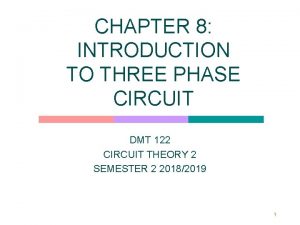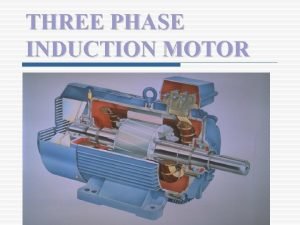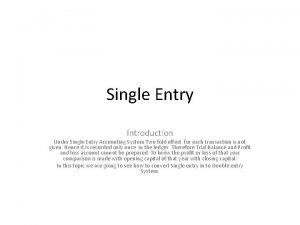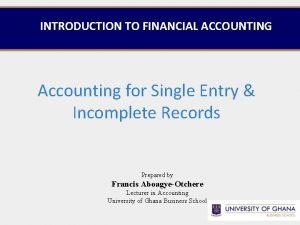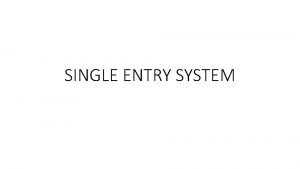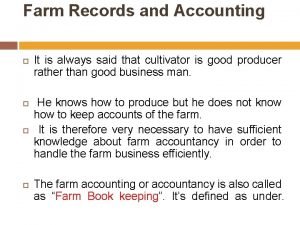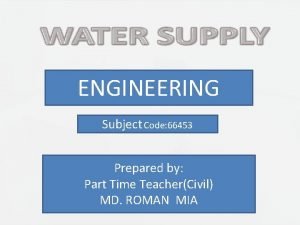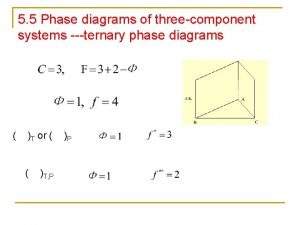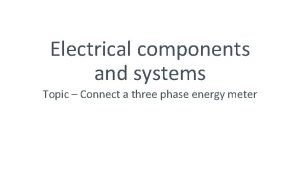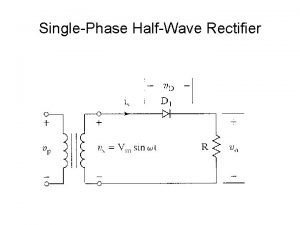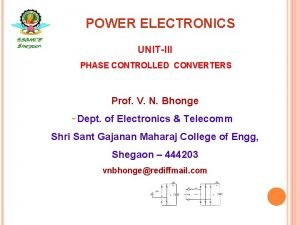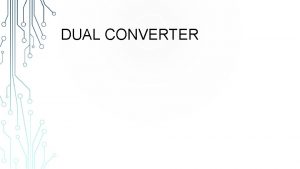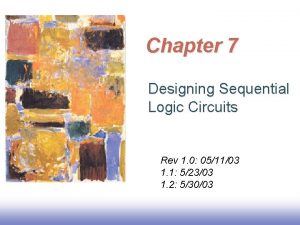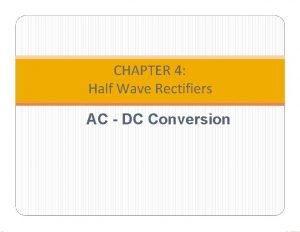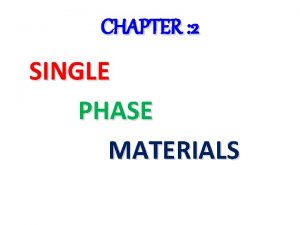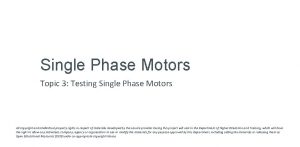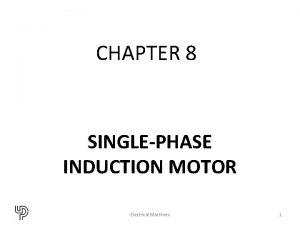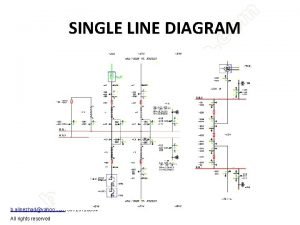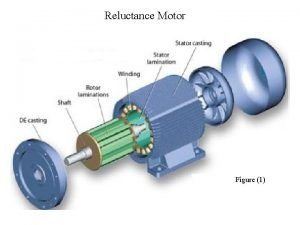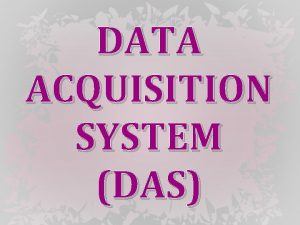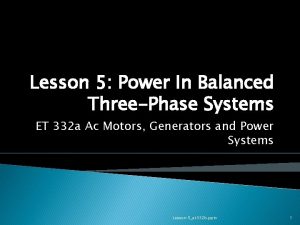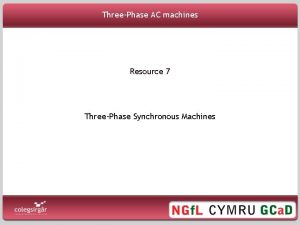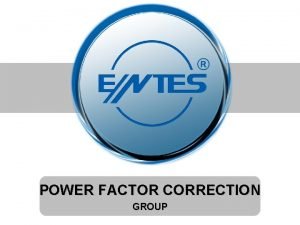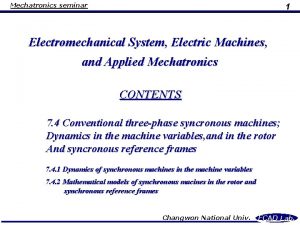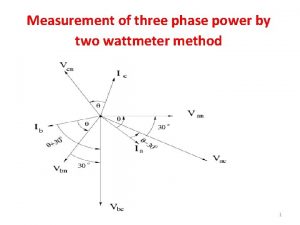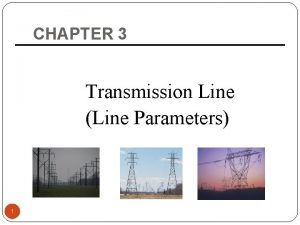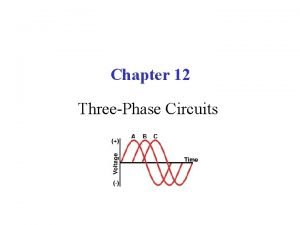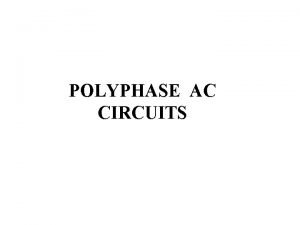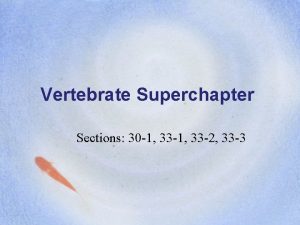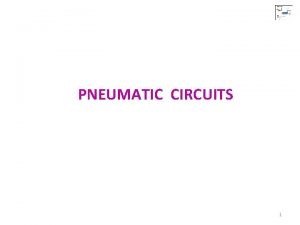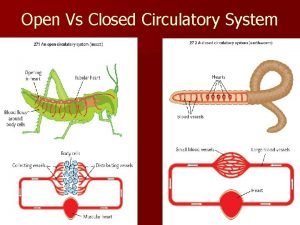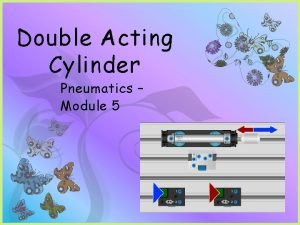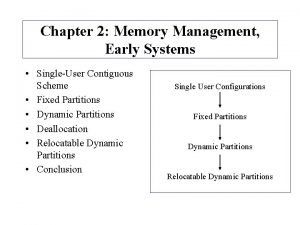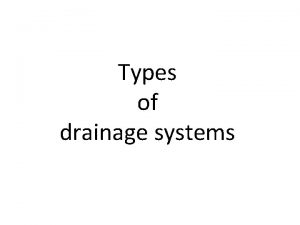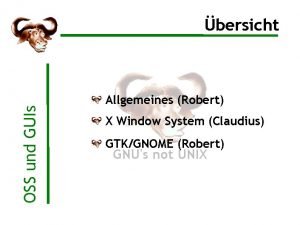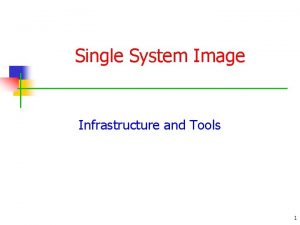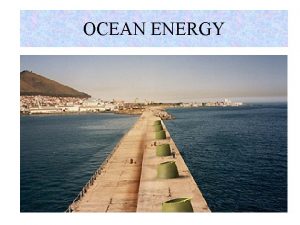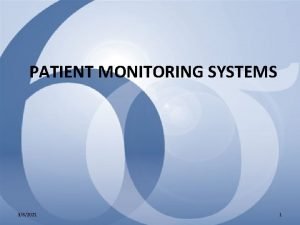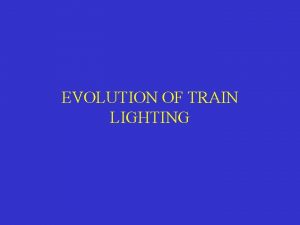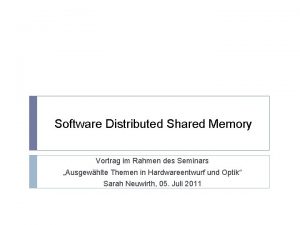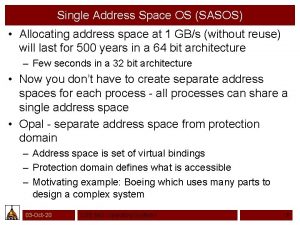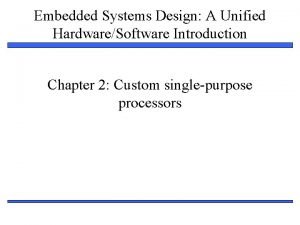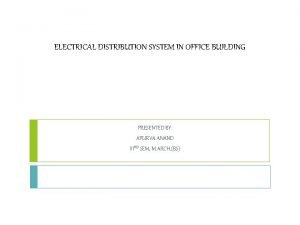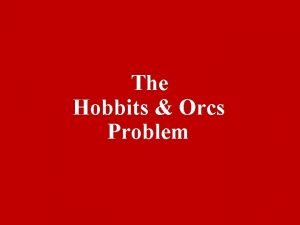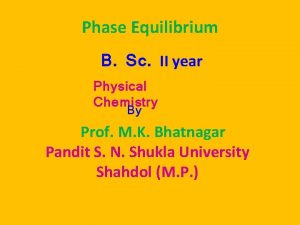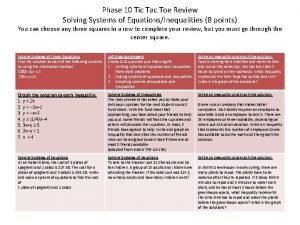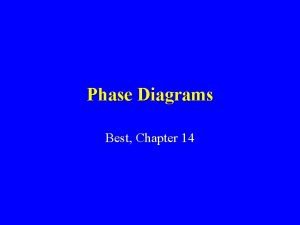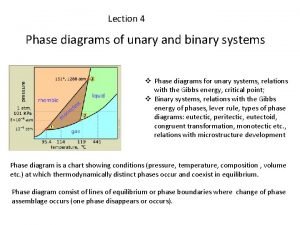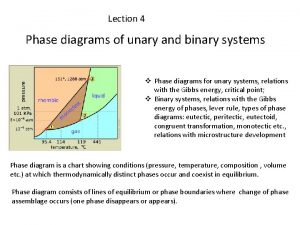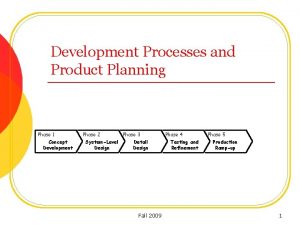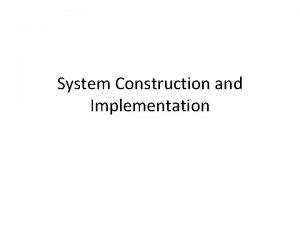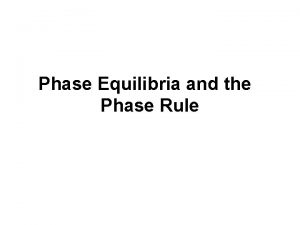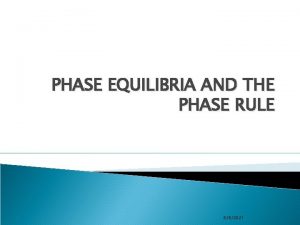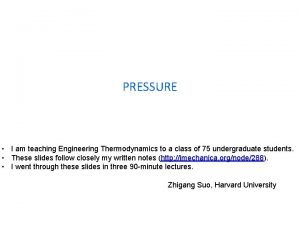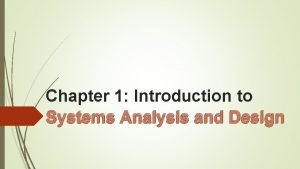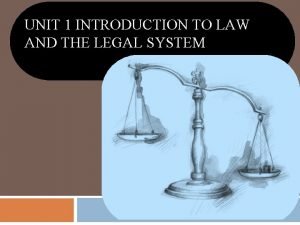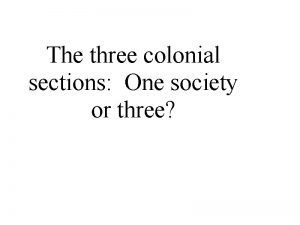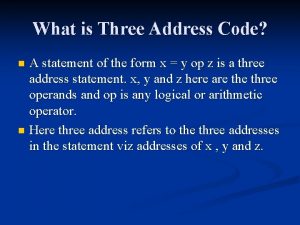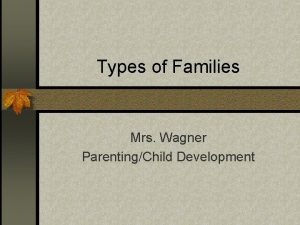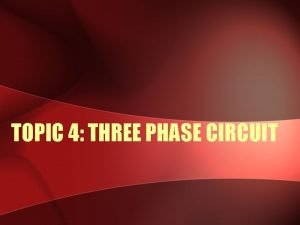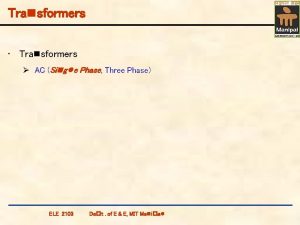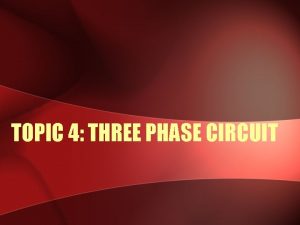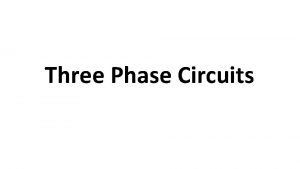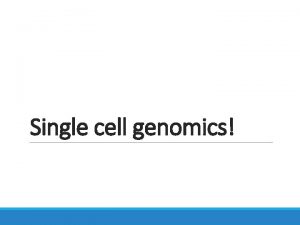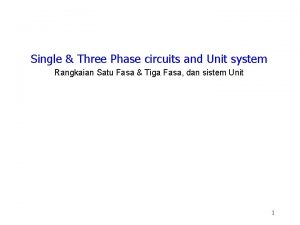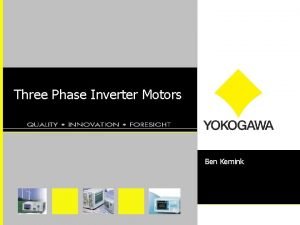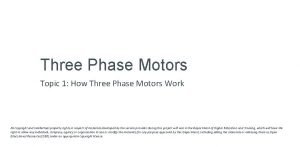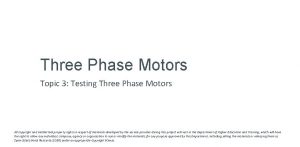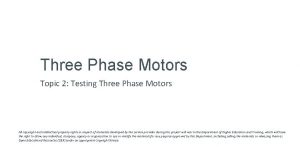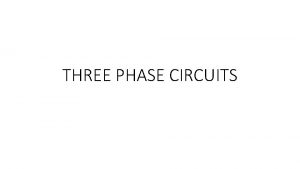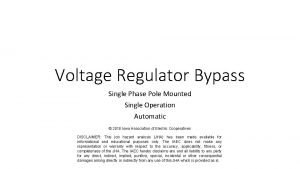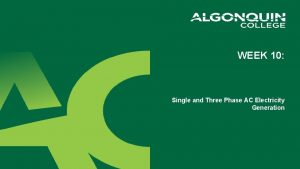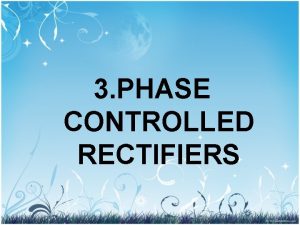THREE PHASE SYSTEM Introduction Single Phase and Three
































































































- Slides: 96

THREE PHASE SYSTEM • Introduction: Single Phase and Three Phase System • Advantage of three-phase system compare to single-phase system • Y connection system • Δ connection system • Voltage and current in star-connected system • Voltage and current in delta-connected system • Power calculation in three-phase system with balanced load • # Unbalanced three-phase system

Introduction: Single Phase System • Alternating current system that has one source/supply normally known as SINGLE PHASE SYSTEM. A VAa a

VOLTAGE WAVE AND PHASOR DIAGRAM FOR SINGLE PHASE SYSTEM voltage Phasor Diagram V 1 t V 1

THREE PHASE SYSTEM • If three single phase system combined, it will produce THREE PHASE SYSTEM. • Voltage in three phase system are equal in magnitude and frequency but of phase with each other by 120º. • So, generated phase voltage had been produced by using three coils that must be rotate through the north and south pole, and these coils must be separated by 120º

Basic Three-Phase Circuit Three-Phase Line Three. Phase Voltage Source Three. Phase Load

3 PHASE VOLTAGE SINUSOIDAL WAVE voltage VA VB VC t 120º 240º

• • Normally, we take VA as a reference to VC and VB. So, there are TWO relationship between voltage VA, VB and VC : i. VB lagging VA by 120º and VC leading VA by 120º. This is known as Sequence ABC (positive) ii. VB leading VA by 120º dan VC lagging VA by 120º. This is known as Sequence ACB (negatif)

POSITIVE SEQUENCE, ABC NOTE!! Vm: peak voltage NEGATIVE SEQUENCE, ACB

POSITIVE SEQUENCE, ABC VC 120º VA 120º VB

NEGATIVE SEQUENCE, ACB VB 120º VA 120º VC

THREE PHASE VOLTAGE SOURCE Y-Connection

THREE PHASE VOLTAGE SOURCE Δ-Connection

A Model of three-phase source with winding impedance (Rw + j. Xw) Δ-connection

Y-connection

THREE PHASE SYSTEM LOAD Three-Phase system Load are divided into TWO: • BALANCED LOAD: load that has the same or equal impedance • UNBALANCED LOAD: load that has different or not equal impedance.

Advantages of three-phase system compare to single-phase system • Three-phase transformer is much lighter, better efficiency and more economical compare to single-phase transformer that has same size. • Three-phase motor produce permanent torque while single-phase induction motor produce torque in pulse. • Three-phase motor have power factor and much better efficiency and small size for the same output compare to single-phase motor. • Three-phase motor is self-starter compared to single-phase motor that is not self-starter.

THREE PHASE SYSTEM CONNECTION • There are TWO types of connection: i. STAR connection ii. DELTA connection • • Each of this connection is differ in terms of relationship between voltage or current. This connection is connected to both LOAD and SOURCE.

(1) STAR CONNECTION a) Star Connection-Three Wire: OR

b) Star Connection-Four Wire OR

Y-Y Analysis

Single Phase equivalent circuit (a phase as a reference)

Line Voltage Source in Star Connection

Phase Voltage Source in Star Connection

STAR CONNECTION IN BALANCED SYSTEM In general, Line Voltage Phase Voltage Vp Line Current Phase Current Ip

RELATIONSHIP BETWEEN PHASE VOLTAGE AND LINE VOLTAGE a) POSITIVE SEQUENCE, ABC b) NEGATIVE SEQUENCE, ACB

Line Voltage in Star Connection

a) POSITIVE SEQUENCE By consider phase voltage VAN as a reference;

Line Voltage AB can be accomplished as follows:

Line Voltage BC can be accomplished as follows:

Line Voltage CA can be accomplished as follows:

PHASE VOLTAGE LINE VOLTAGE

PHASOR DIAGRAM VL, VP POSITIVE SEQUENCE VCA VCN VAB 30º 120º 30º VBN VBC 120º VAN

POSITIVE SEQUENCE CHARACTERISTICS: a) Line Voltage, VL is √ 3 phase voltage, Vf : b) Line Voltage, VL LEADING phase voltage, Vp by 30º; c) Line Current, IL is equal to phase current, Ip :

b) NEGATIVE SEQUENCE By consider the phase voltage VAN as a reference;

Line Voltage AB can be accomplished as follow:

Line Voltage BC can be accomplished as follows:

Line Voltage CA can be accomplished as follows:

PHASE VOLTAGE LINE VOLTAGE

PHASOR DIAGRAM VL, VP NEGATIVE SEQUENCE VBC VBN 30º 120º 30º VCA VCN 30º 120º VAN VAB

NEGATIVE SEQUENCE CHARACTERISTICS: a) Line Voltage, VL is √ 3 phase voltage, Vp : b) Line Voltage, VL LAGGING phase voltage, Vp by 30º; c) Line Current, IL is equal to phase current, Ip :

(2) DELTA-CONNECTION OR

Phase Current in Delta Connection

Line Current in Delta Connection

BALANCE SYSTEM IN DELTACONNECTION

RELATIONSHIP BETWEEN PHASE CURRENT AND LINE CURRENT a) POSITIVE SEQUENCE, ABC b) NEGATIVE SEQUENCE, ACB

Line Current/Voltage in Delta Connection

(a) POSITIVE SEQUENCE By considered phase current IAB as a reference;

Line Current A can be accomplished as follow:

Line Current B can be accomplished as follow:

Line Current C can be accomplished as follow:

PHASE CURRENT LINE CURRENT

PHASOR DIAGRAM IL, Ip POSITIVE SEQUENCE IC ICA 30º 120º 30º IB IBC 30º 120º IAB IA

POSITIVE SEQUENCE CHARACTERISTICS: a) Line current, IL is √ 3 phase current, Ip : b) Line current, IL LAGGING phase current, Ip by 30º; c) Line Voltage, VL is equal to phase voltage, Vp :

(b) NEGATIVE SEQUENCE By considered phase current IAB as a reference;

Line Current A can be accomplished as follow:

Line current B can be accomplished as follow:

Line Current C can be accomplished as follow:

PHASE CURRENT LINE CURRENT

PHASOR DIAGRAM IL, Ip NEGATIVE SEQUENCE IB IBC IA 120º 30º ICA IC 120º IAB

NEGATIVE SEQUENCE CHARACTERISTICS: a) Line current, IL is √ 3 phase current, Ip : b) Line current, IL LEADING phase current, Ip by 30º; c) Line Voltage, VL is equal to phase Voltage, Vp :

CONNECTION TYPES Source Load Connection Star Y-Y Star Delta Y- Delta Star -Y

Example 1 A balanced three phase Y-connection generator with positive sequence has an impedance of 1. 2+j 0. 5Ω per phase and inner voltage 240 V per phase. The generator connected with load balanced three-phase Y-connection that has an impedance of 38+j 24Ω per phase. Line Impedance that connected to the source and load is 1. 8+j 2. 5Ω per phase. If inner voltage of a-phase generator is considered as reference,

a) Define the a-phase equivalent circuit for this system. b) Calculate the line current Ia. A, Ib. B a and Ic. C c) Calculate all the three phase voltage at the load, VAN, VBN and VCN d) Calculate all the three line voltage, VAB, VBC and VCA at the load terminal. e) Calculate the phase voltage at generator/source terminal, Van, Vbn and Vcn f) Calculate the line voltage Vab, Vbc and Vca at the generator/source terminal.

Answer (a) • a-phase equivalent circuit

Answer (b) • a-phase line current:

• For the positive sequence:

Answer (c) • Phase voltage at the a-terminal load:

• For the positive sequence:

Answer (d) • For the positive sequence, line voltage leading phase voltage by 30 o, so,

Answer (e) • Phase Voltage at the a-terminal generator/source:

• For the positive sequence:

Answer (f) • Line Voltage at the generator terminal:

POWER CALCULATION • AVERAGE POWER IN BALANCED STAR LOAD • COMPLEX POWER IN BALANCED STAR LOAD • POWER CALCULATION IN BALANCED DELTA LOAD

STAR-CONNECTED LOAD IA A + IB IC B C + VBN ZB ZA - N ZC VAN VBN +

(1) STAR CONNECTED POWER Average Power at Line A: where, VA and i. A is the phase angle for VAN and IA.

By the same method, the average power at line B and C can be also accomplished:

AVERAGE POWER

In balanced star-connected three-phase system, MAGNITUDE for each phase-line voltage and phase current is EQUAL: Phase-line Voltage Phase-line current

• We can concluded that the power received by each phase which are PA, PB, and PC is equal: • P represents average power for each phase. (i. e. average power phase).

• By knowing TOTAL average power that been received by load in balanced three-phase system, we just total up the average power for each phase: • PT represents the total average power that been received by the load in star-connected three-phase system.

• If we have line voltage, VL and line current, IL so the equation for total average power, PT can be write as follows: The angle difference between phase Voltage and phase current • VL=Line Voltage, and IL=Line Current.

REMEMBER! • Phase Voltage normally can be represented by Vp or V. • Phase Voltage for star-connection are as follows: VAN, VBN, and VCN.

TOTAL AVERAGE POWER, PT Total average power in phase voltage and phase current. Total average power in line voltage and line current.

REACTIVE POWER FOR STARCONNECTED LOAD Reactive Power, Q and complex power, S can be considered for star-connected load:

COMPLEX POWER • Complex Power can be calculated as follows: • where, V and I represents voltage and current for the specific phase. So, generally:

(2) DELTA-CONNECTED POWER • Average Power for each phase in DELTAconnected are as follows:

For Balanced Delta load; So,

AVERAGE POWER Total Average Power that been received by deltaconnected load is:

REACTIVE POWER Reactive Power for each phase and Total Reactive Power at the load can be accomplished as follows:

COMPLEX POWER And, complex power for each phase and total complex power is:

Example: Based on the previous example, calculate, a) Average Power phase that been sent Yconnected load b) Total Average Power that been sent to the load c) Total Average Power that been loss in line d) Average Power that loss in generator/source

Answer (a) • From the previous example:

• Average Power phase:

Answer (b) • Total Average Power that been sent to the load

Answer (c) • Total loss power in the line

Answer (d) • Total Loss Average Power in generator/source
 Single channel single phase example
Single channel single phase example Introduction to three phase system
Introduction to three phase system Parts of 3 phase induction motor
Parts of 3 phase induction motor Single entry system introduction
Single entry system introduction Single entry system introduction
Single entry system introduction Double entry method
Double entry method Single entry system and double entry system
Single entry system and double entry system Pe pipe jointing machine
Pe pipe jointing machine Three component system phase diagram
Three component system phase diagram Three phase system
Three phase system Mobile phase and stationary phase
Mobile phase and stationary phase Stationary phase and mobile phase in hplc
Stationary phase and mobile phase in hplc Which detector used in hplc
Which detector used in hplc Multiple instruction single data example
Multiple instruction single data example Dataxin
Dataxin Single phase half wave rectifier
Single phase half wave rectifier 3 phase full converter
3 phase full converter Single phase gels
Single phase gels 3 phase dual converter
3 phase dual converter Which flip flop is insensitive to clock overlap
Which flip flop is insensitive to clock overlap Controlled full wave rectifier with rl load
Controlled full wave rectifier with rl load Material selection diagram
Material selection diagram Rms output voltage
Rms output voltage Testing single phase motors
Testing single phase motors Single phase induction motor
Single phase induction motor Busbar single line diagram
Busbar single line diagram Reluctance motor
Reluctance motor Normal phase vs reverse phase chromatography
Normal phase vs reverse phase chromatography Hplc reverse phase vs normal phase
Hplc reverse phase vs normal phase Normal phase vs reverse phase chromatography
Normal phase vs reverse phase chromatography Difference between phase voltage and line voltage
Difference between phase voltage and line voltage Phase to phase voltage
Phase to phase voltage Broad phase vs narrow phase
Broad phase vs narrow phase Single user and multi user operating system
Single user and multi user operating system Single user and multiple user operating system
Single user and multiple user operating system Data acquisition system (das)
Data acquisition system (das) Open closed and isolated systems
Open closed and isolated systems Respiratory system circulatory system digestive system
Respiratory system circulatory system digestive system Variable ratio schedule
Variable ratio schedule Ac systems lesson 5
Ac systems lesson 5 Ac systems lesson 4
Ac systems lesson 4 Double subscript notation in three phase
Double subscript notation in three phase Pony motor starting method
Pony motor starting method Three phase synchronous generator
Three phase synchronous generator Shunt reactors for power factor correction
Shunt reactors for power factor correction Three phase synchronous generator
Three phase synchronous generator Three-phase power
Three-phase power Gmr of 3 strand conductor
Gmr of 3 strand conductor Three phase circuits
Three phase circuits Polyphase circuits
Polyphase circuits Non vertebrate chordates
Non vertebrate chordates Darkroom illumination
Darkroom illumination Single circulation and double circulation
Single circulation and double circulation Single acting cylinder pneumatic
Single acting cylinder pneumatic Open circulatory system vs closed
Open circulatory system vs closed Indirect pneumatic circuit
Indirect pneumatic circuit Single user contiguous scheme
Single user contiguous scheme Partially vented single stack system
Partially vented single stack system Window
Window Single system image cluster
Single system image cluster Wagon air brake system
Wagon air brake system Single system image cluster
Single system image cluster Single pool tidal system
Single pool tidal system Single parameter monitoring system
Single parameter monitoring system Train lighting system
Train lighting system Kohärenz
Kohärenz Single address space
Single address space Single use mixing system
Single use mixing system Single purpose processor
Single purpose processor Electrical distribution system in building
Electrical distribution system in building Single address space
Single address space Hobbits and orcs problem psychology
Hobbits and orcs problem psychology Ferric chloride water system phase diagram
Ferric chloride water system phase diagram Phase 10 points system
Phase 10 points system System development life cycle implementation phase
System development life cycle implementation phase Gibbs phase rule for general system
Gibbs phase rule for general system Unary system diagram
Unary system diagram Unary and binary phase diagram
Unary and binary phase diagram Concept development phase
Concept development phase System construction
System construction Auto component phenol water system the phase rule is
Auto component phenol water system the phase rule is 662021
662021 Generalized linear phase
Generalized linear phase Vaporfix
Vaporfix Essay structure introduction
Essay structure introduction Sad system analysis and design
Sad system analysis and design Introduction to system analysis and design
Introduction to system analysis and design Unit 1 introduction to law and the legal system
Unit 1 introduction to law and the legal system Othello act three summary
Othello act three summary In three minutes write three things you did yesterday
In three minutes write three things you did yesterday Orange diamond-shaped signs warn the motorist of
Orange diamond-shaped signs warn the motorist of The three colonial sections-one society or three
The three colonial sections-one society or three Three addresses in three address code are
Three addresses in three address code are Blended family advantages and disadvantages
Blended family advantages and disadvantages Single basin and double basin tidal power plant
Single basin and double basin tidal power plant Sql
Sql Two stage tender
Two stage tender

